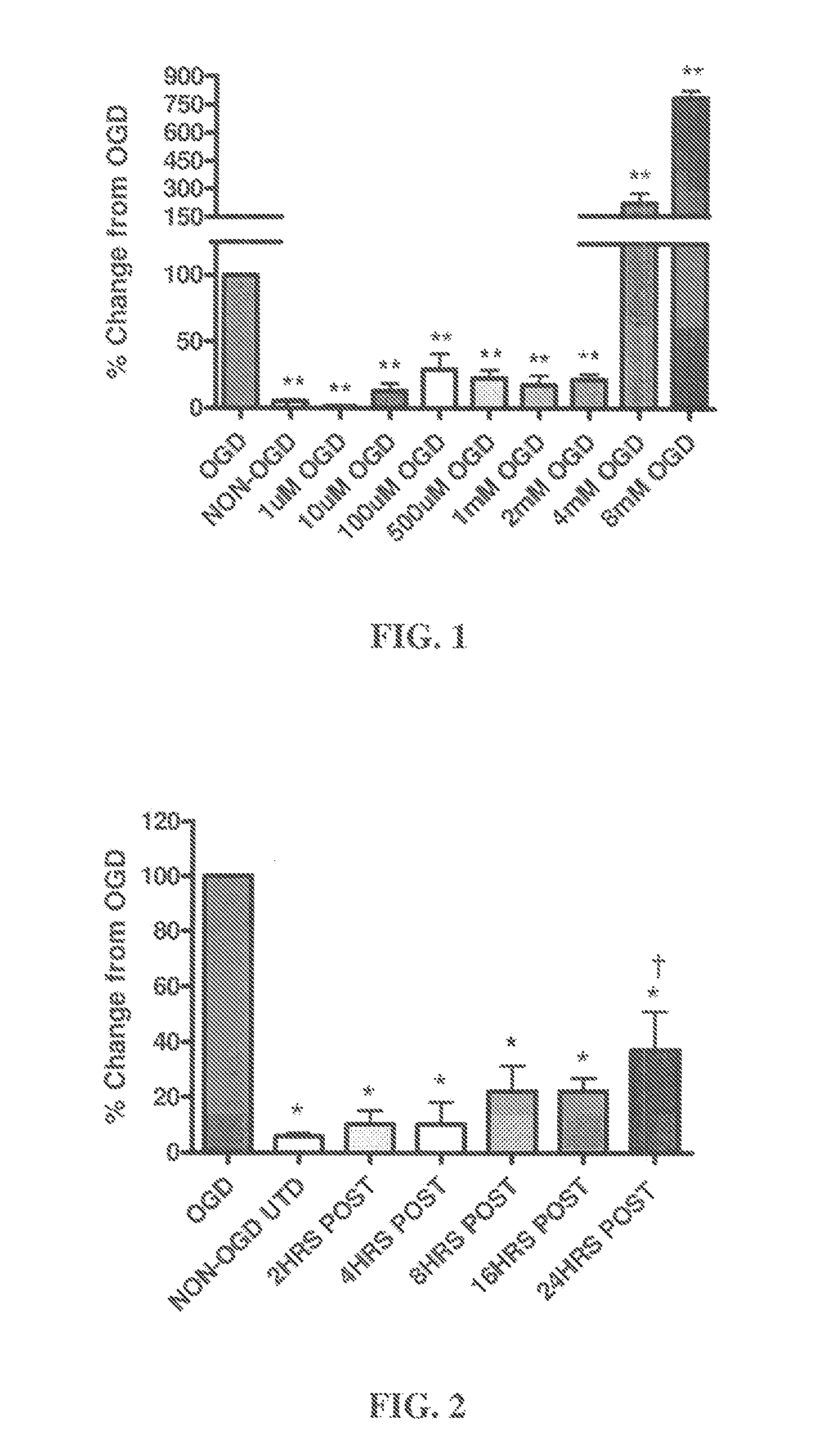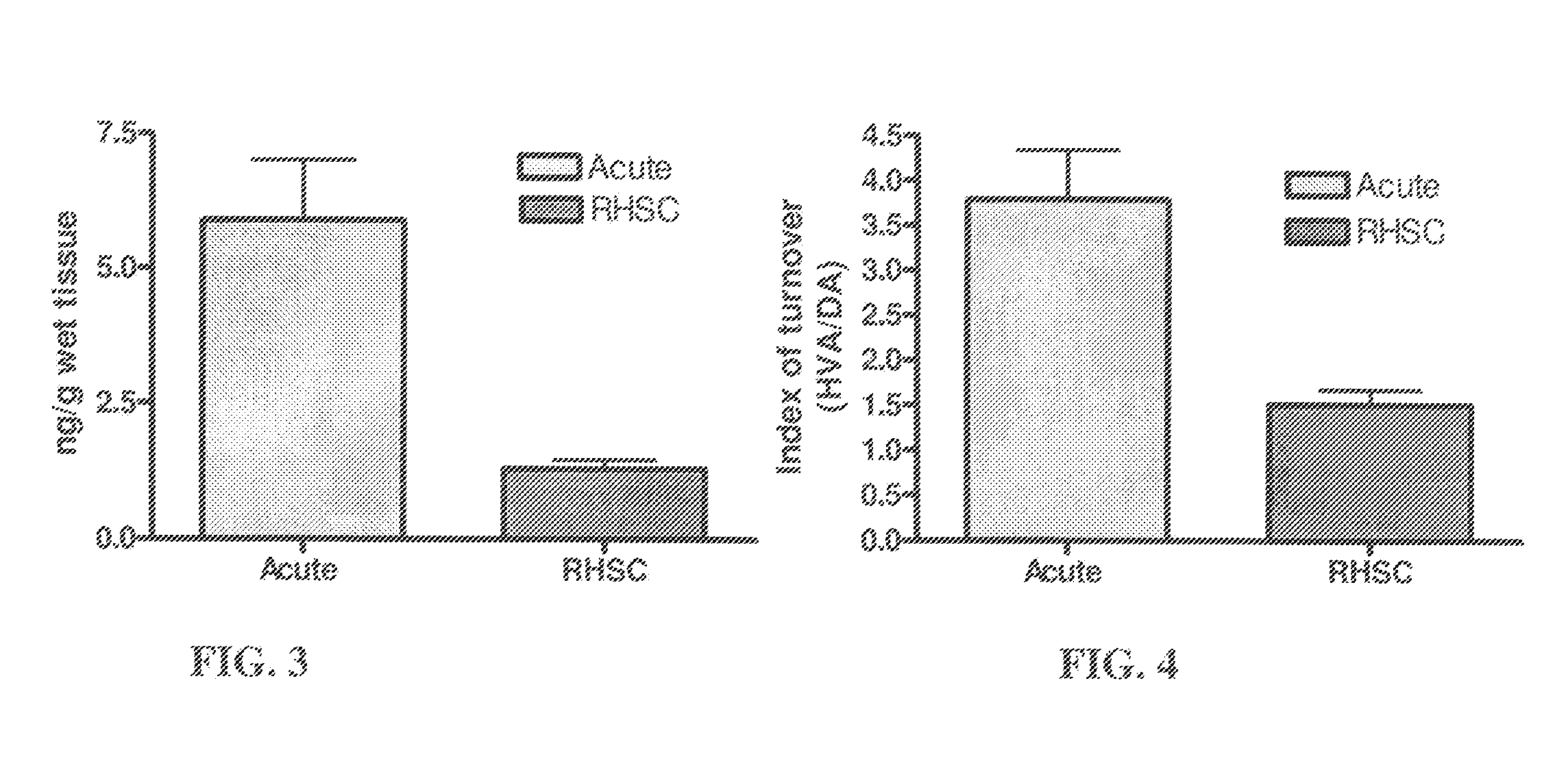Method of reducing brain cell damage, inflammation or death
a brain cell damage and inflammation technology, applied in the field of brain cell damage reduction, can solve the problems of amphetamines not improving recovery, affecting cognitive tasks, and no preventative or neuroprotective therapy has proven to be effective in humans, so as to reduce the occurrence of brain cell damage or death, the effect of reducing the occurrence of brain cell damag
- Summary
- Abstract
- Description
- Claims
- Application Information
AI Technical Summary
Benefits of technology
Problems solved by technology
Method used
Image
Examples
example 1
In Vitro Hippocampal Slice Studies
1.1 Materials and Methods
Hippocampal Slice Culture Preparation:
[0077]All experimental animal procedures were approved by the University Institutional Animal Care and Use Committee. Neonatal rats (Sprague-Dawley) at postnatal Day 7 (P7) were decapitated and the hippocampi dissected out under sterile conditions. 400 μm transverse hippocampal slices were prepared with a McIlwain tissue chopper and cultured on Millicell permeable membranes (0.4 μM pore size) in six well plates for 6 days at 37° C. in 5% CO2. Slices were maintained in a primary plating media for two days (50% DMEM (+) glucose, 25% HBSS (+) glucose, 25% heat inactivated horse serum, 5 mg / mL D-glucose (Sigma), 1 mM Glutamax, 1.5% PenStrep / Fungizone (Gibco), and 5 mL of 50× B27 (Gibco) supplement plus anti-oxidants that was changed every 24 hr. Next, the slices were placed in serum-free neurobasal medium (10 mL Neurobasal-A, 200 μL of 50× B27 supplement, 100 μL of 100× Fungizone, and 100 μL...
example 2
Alterations in Gene Expression
2.1 Materials and Methods
[0100]Six adult, male Sprague-Dawley rats were injected IP with a single dose of 1 mg / kg methamphetamine. Four additional control rats received IP injections with equal volumes of saline. Three rats from each group were euthanized at one hour after injection. The remaining three were euthanized at six hours after injection. Both hippocampi from each animal were recovered and processed as separate samples. Changes in the expression of specific genes were determined by quantitative real time PCR analysis using the neurotrophin and receptor array and RT2 Profiler PCR Array System according to the manufacturers instructions (SA Biosciences, Fredricksberg, Md.). Total RNA was isolated from hippocampal tissue then RNA quality and quantity was established with an Agilent 2100 bioanalyzer. Samples from each hippocampus were run in triplicate and analyzed using software provided by SA bioscience. Only genes that showed a statistically si...
example 3
In Vivo Transient Cerebral Ischemia
3.1 Materials and Methods
Induction of Transient Cerebral Ischemia:
[0105]Gerbils were anesthetized with isoflurane and core-body temperature maintained at 37-38 C during surgery using a homeothermic blanket (Harvard Apparatus, South Natick, USA). A midline incision was made in the neck and the common carotid arteries were isolated and occluded for 5 min using 85-gm pressure aneurysm clips (ISCH; n=14). A second group of gerbils (SHAM; n=14) underwent the identical procedure except the carotid arteries were not clamped. The incision was sutured and animals received MAP (5 mg / kg; i.p) or equal volume of vehicle (saline; 0 mg) within 2 minutes of reperfusion. Animals were placed in a warmed cage, and observed for 30 minutes. Tylenol (8 mg / ml) was added to drinking water to provide postoperative analgesia.
Behavioral Testing and Histological Evaluation:
[0106]Each gerbil was tested 48 hrs following surgery in an open-field apparatus consisting of a metal ...
PUM
| Property | Measurement | Unit |
|---|---|---|
| concentration | aaaaa | aaaaa |
| concentration | aaaaa | aaaaa |
| pore size | aaaaa | aaaaa |
Abstract
Description
Claims
Application Information
 Login to View More
Login to View More - R&D
- Intellectual Property
- Life Sciences
- Materials
- Tech Scout
- Unparalleled Data Quality
- Higher Quality Content
- 60% Fewer Hallucinations
Browse by: Latest US Patents, China's latest patents, Technical Efficacy Thesaurus, Application Domain, Technology Topic, Popular Technical Reports.
© 2025 PatSnap. All rights reserved.Legal|Privacy policy|Modern Slavery Act Transparency Statement|Sitemap|About US| Contact US: help@patsnap.com



